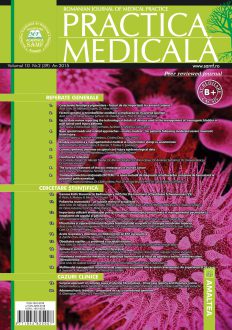SELECT ISSUE

Indexed

| |

|
|
|
| |
|
|
|

|
|
|
|
|
|
|
HIGHLIGHTS
National Awards “Science and Research”
NEW! RJMP has announced the annually National Award for "Science and Research" for the best scientific articles published throughout the year in the official journal.
Read the Recommendations for the Conduct, Reporting, Editing, and Publication of Scholarly work in Medical Journals.
The published medical research literature is a global public good. Medical journal editors have a social responsibility to promote global health by publishing, whenever possible, research that furthers health worldwide.
Gamma Knife Stereotactic Radiosurgery (GKS) for the treatment of Vestibular Schwannomas (VS)
R. PERIN, A. MOHAN, H. MOISA and A.V. CIUREA
ABSTRACT
Introduction. Vestibular schwannomas (VS) or acoustic neuromas (AN) (as they are known to neurosurgeons) are benign tumors which originate at the junction between central nervous system myelin and peripheral nervous system myelin – an area known as the Obersteiner – Redlich area. Acoustic neuromas represent a special pathologic entity for neurosurgeons due to their important symptoms which need to be adressed as soon as possible and due to the secondary disfunctions which may appear if the tumors are not treated appropriately.
Materials and methods. The study below presents the experience of the authors regarding the use of stereotactic radiosurgery for the treatment of acoustic neuromas. The authors focus on a population of 231 patients diagnosed and treated for VS over a period of 10 years at the „Bagdasar-Arseni“ University Hospital in Bucharest. This study compares the impact of Gamma Knife Surgery when performed alone or in association with open microneurosurgery. The authors assessed patients with tumors ranging between 0.25 and 14 cm3 in volume. Gamma Knife Surgery is used successfully to treat VS, both independantly or in association with open microsurgery.
Results. The major complications of the treatment are represented by lack of response to treatment (less than 1% of patients) and cerebral edema (16.4% of patients).
Conclusions. Given the multiple advantages it has, stereotactic radiosurgery is right now the tip of the spear regarding the therapeutical means available for VS. When the tumors met in daily practice are larger than the therapeutical resources of the devices used for Gamma Knife Surgery an open microsurgical approach may be attempted followed by stereotactic iradiation of the remnant tumor.
Given the large number of successes reported in the literature and the small number of complications but also the ever progressing technology used to improve Gamma Knife devices, the authors consider stereotactic radiosurgery to be a very good solution for the treatment of VS. Furthermore, the improvement potential this technique has grants it the potential to improve standard of treatment for acoustic neuromas and the quality of life in patients with this disease.
Keywords: Vestibular Schwannomas, acoustic neuromas, stereotactic radiosurgery, microneurosurgery, GKS, MRI
